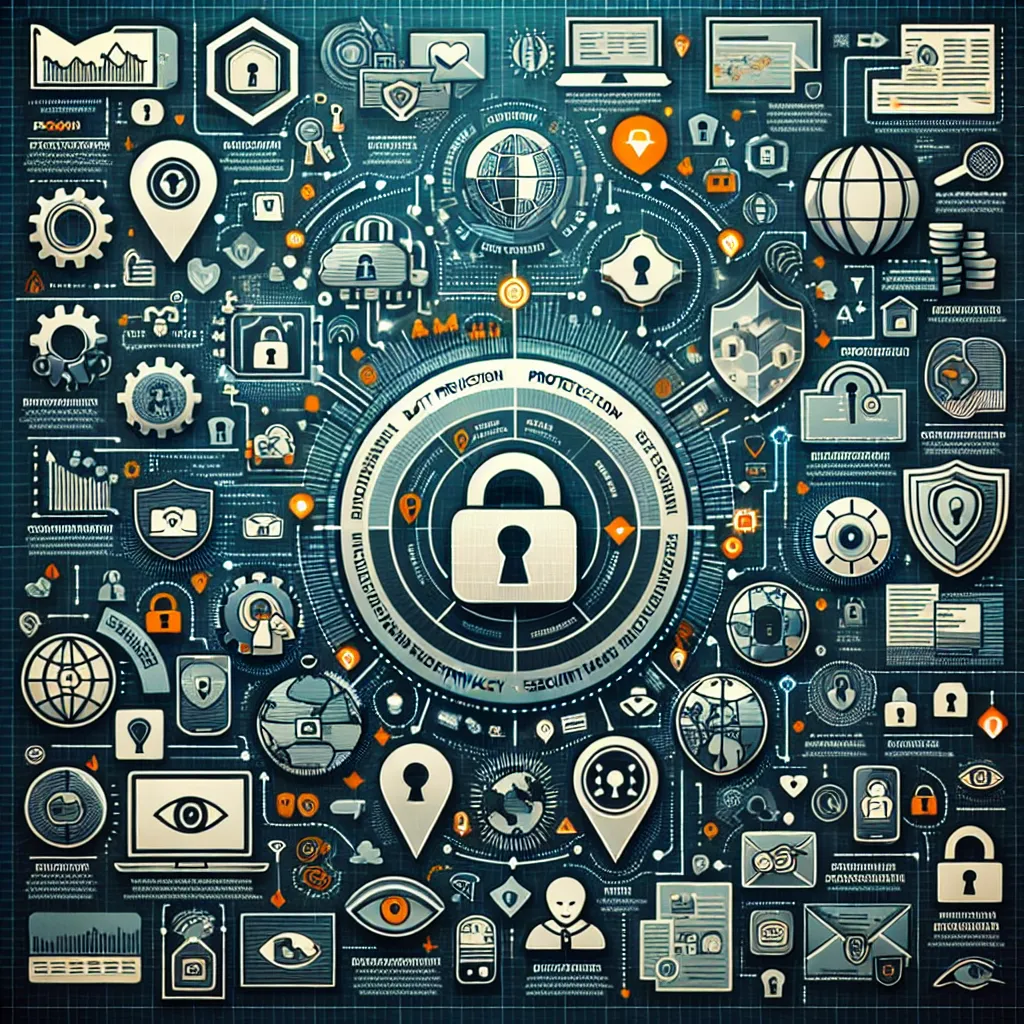As an experienced IELTS instructor, I’m excited to share a comprehensive reading practice focused on the “Impact of the Internet on Privacy and Security.” This topic is not only relevant to modern life but also frequently appears in IELTS exams. Let’s dive into a full IELTS Reading test, complete with passages, questions, and answers to help you prepare effectively.
 IELTS Reading Test on Internet Privacy
IELTS Reading Test on Internet Privacy
Introduction
The internet has revolutionized our lives, but it has also raised significant concerns about privacy and security. This IELTS Reading practice test explores various aspects of this crucial topic, challenging your comprehension skills while providing valuable insights into the digital age.
IELTS Reading Test: The Impact of the Internet on Privacy and Security
Passage 1 – Easy Text
The Digital Footprint
In today’s interconnected world, every click, like, and share leaves a trace. This digital footprint, the trail of data we create while using the internet, has become a subject of increasing concern. From social media posts to online purchases, our digital activities paint a detailed picture of our lives, preferences, and behaviors.
The concept of privacy in the digital age has evolved dramatically. What was once considered personal information is now often freely shared online. Many users are unaware of the extent to which their data is collected, stored, and analyzed by various entities, including tech companies, advertisers, and sometimes, malicious actors.
One of the primary concerns surrounding digital footprints is data breaches. These incidents, where sensitive information is exposed or stolen, can have severe consequences. Personal details, financial information, and even biometric data can fall into the wrong hands, leading to identity theft, financial fraud, or other forms of cybercrime.
However, it’s not all doom and gloom. The awareness of digital footprints has led to positive changes in online behavior. Many users are now more cautious about what they share online and are taking steps to protect their privacy. Additionally, governments and organizations are implementing stricter data protection regulations to safeguard user information.
As we continue to navigate the digital landscape, understanding and managing our digital footprints will be crucial. It’s a balancing act between enjoying the benefits of the internet and protecting our privacy and security in an increasingly connected world.
Questions 1-5
Do the following statements agree with the information given in the passage?
Write:
TRUE if the statement agrees with the information
FALSE if the statement contradicts the information
NOT GIVEN if there is no information on this
- Every online activity contributes to a person’s digital footprint.
- Most internet users fully understand how their data is collected and used.
- Data breaches can result in identity theft and financial fraud.
- All countries have implemented strict data protection laws.
- Managing digital footprints requires balancing internet benefits with privacy concerns.
Questions 6-10
Complete the sentences below.
Choose NO MORE THAN TWO WORDS from the passage for each answer.
- The trail of data created by internet usage is called a ___.
- Many users freely share what was once considered ___ information.
- ___ can have severe consequences when sensitive information is exposed.
- Awareness of digital footprints has led to positive changes in ___ behavior.
- Understanding digital footprints is crucial for navigating the ___ landscape.
Passage 2 – Medium Text
The Double-Edged Sword of Big Data
The proliferation of big data has transformed the landscape of privacy and security in the digital age. This vast collection of information, gathered from countless online interactions, has become both a powerful tool for innovation and a source of significant concern.
On one hand, big data has revolutionized numerous sectors. In healthcare, it enables personalized medicine and early disease detection. Predictive analytics, powered by big data, helps businesses make informed decisions and improve customer experiences. Urban planners utilize big data to create smarter, more efficient cities. The potential benefits seem limitless.
However, the dark side of big data cannot be ignored. The sheer volume of personal information being collected raises serious privacy concerns. Companies can build detailed profiles of individuals, tracking their habits, preferences, and even predicting future behaviors. This level of surveillance, often conducted without explicit consent, blurs the line between personalization and invasion of privacy.
Moreover, the centralization of vast amounts of data creates significant security risks. Data breaches have become increasingly common and catastrophic in scale. When hackers gain access to these data repositories, millions of individuals can be affected simultaneously. The potential for misuse of this information by malicious actors is a constant threat.
The ethical implications of big data usage are also under scrutiny. Questions arise about who owns the data, how it should be used, and what limits should be placed on its collection and analysis. The power imbalance between data collectors and individuals is stark, with many people feeling powerless to control their own information.
Governments and regulatory bodies are grappling with these challenges. Legislation like the European Union’s General Data Protection Regulation (GDPR) aims to give individuals more control over their personal data. However, the rapid pace of technological advancement often outstrips the ability of laws to keep up.
As we move forward, striking a balance between harnessing the power of big data and protecting individual privacy will be crucial. Transparency in data collection and usage, robust security measures, and ethical guidelines for data analysis are all essential components of this balance. Individuals, too, must become more aware and proactive in managing their digital presence.
The impact of big data on privacy and security is profound and multifaceted. While it offers unprecedented opportunities for progress and innovation, it also poses significant risks that must be carefully managed. As our digital footprints continue to grow, so too must our understanding and safeguarding of our personal information in this data-driven world.
Questions 11-14
Choose the correct letter, A, B, C, or D.
-
According to the passage, big data has:
A) Only negative impacts on society
B) Transformed various sectors including healthcare and urban planning
C) Been completely regulated by governments
D) Eliminated all privacy concerns -
The main privacy concern related to big data is:
A) The inability to use online services
B) The high cost of data storage
C) The detailed profiling of individuals without explicit consent
D) The slow internet speeds due to data overload -
Data breaches are described in the passage as:
A) Rare occurrences with minimal impact
B) Easily preventable with current technology
C) A significant threat affecting millions simultaneously
D) A problem only for large corporations -
The passage suggests that the solution to big data challenges includes:
A) Completely stopping data collection
B) Ignoring privacy concerns for the sake of progress
C) Balancing data use with privacy protection and ethical guidelines
D) Allowing unrestricted data collection and use
Questions 15-19
Complete the summary below.
Choose NO MORE THAN TWO WORDS from the passage for each answer.
Big data has had a significant impact on privacy and security in the digital age. While it offers benefits such as personalized medicine and (15) in business, it also raises serious concerns. The collection of personal information allows companies to create detailed (16) of individuals, often without their explicit consent. This data centralization also creates (17) risks, as breaches can affect millions simultaneously. The (18) of big data usage are under scrutiny, with questions about data ownership and usage limits. Governments are attempting to regulate through legislation like GDPR, but technology often outpaces (19) ___. Balancing the power of big data with individual privacy protection remains a crucial challenge.
Passage 3 – Hard Text
The Cybersecurity Paradigm Shift in the Internet of Things Era
The advent of the Internet of Things (IoT) has ushered in a new era of connectivity, fundamentally altering the landscape of cybersecurity and privacy. This paradigm shift, characterized by the proliferation of interconnected devices, has exponentially expanded the attack surface for potential cyber threats, necessitating a comprehensive reevaluation of traditional security protocols.
The IoT ecosystem, comprising a vast network of sensors, actuators, and smart devices, generates an unprecedented volume of data. This data deluge, while offering immense potential for innovation and efficiency, simultaneously presents formidable challenges in terms of data protection and privacy preservation. The heterogeneous nature of IoT devices, often constrained by limited computational resources and power, renders conventional security measures inadequate.
One of the primary concerns in the IoT paradigm is the issue of device authentication and authorization. The sheer scale and diversity of IoT deployments make it impractical to rely on traditional centralized authentication mechanisms. Consequently, there is a growing emphasis on decentralized and lightweight authentication protocols that can effectively secure device-to-device communications without imposing significant overhead.
Moreover, the pervasive data collection inherent in IoT systems raises profound privacy concerns. The granularity and ubiquity of data gathered by IoT devices can lead to inadvertent disclosure of sensitive information. For instance, smart home devices can potentially reveal intimate details about inhabitants’ lifestyles and habits. This scenario underscores the critical need for privacy-preserving data analytics techniques that can extract valuable insights while safeguarding individual privacy.
The convergence of physical and cyber realms in IoT introduces novel security challenges. Cyber-physical systems, such as industrial control systems and smart grids, are particularly vulnerable to attacks that can have tangible, real-world consequences. A breach in these systems could lead to not just data loss but also physical damage or even loss of life. This blurring of boundaries necessitates a holistic approach to security that encompasses both digital and physical safeguards.
Regulatory frameworks are struggling to keep pace with the rapid evolution of IoT technologies. The transnational nature of IoT deployments further complicates the regulatory landscape, as data may flow across jurisdictional boundaries. This scenario calls for harmonized international standards and regulations that can effectively address the global nature of IoT security and privacy challenges.
The concept of “Security by Design” has gained prominence in the IoT context. This approach advocates for the integration of security and privacy considerations from the inception of IoT product development, rather than as an afterthought. Implementing robust encryption, secure boot processes, and regular firmware updates are some of the key aspects of this proactive security stance.
As IoT continues to permeate various facets of society, from smart cities to healthcare, the imperative for robust security measures becomes increasingly critical. Edge computing paradigms, which bring computation and data storage closer to the point of data generation, are emerging as a potential solution to some IoT security challenges. By processing sensitive data locally, edge computing can mitigate some of the risks associated with data transmission and centralized storage.
The future of IoT security lies in the development of adaptive and context-aware security solutions. These systems must be capable of dynamically adjusting security protocols based on the specific context and risk profile of each device and interaction. Machine learning and artificial intelligence will play a pivotal role in this evolution, enabling real-time threat detection and automated response mechanisms.
In conclusion, the Internet of Things represents a double-edged sword in the realm of cybersecurity and privacy. While it offers unprecedented opportunities for innovation and efficiency, it also introduces complex security challenges that require a paradigm shift in our approach to data protection. As we navigate this new landscape, a concerted effort from technologists, policymakers, and end-users will be crucial in striking the delicate balance between leveraging the benefits of IoT and safeguarding privacy and security in an increasingly connected world.
Questions 20-23
Choose the correct letter, A, B, C, or D.
-
According to the passage, the main challenge in securing IoT devices is:
A) The lack of internet connectivity
B) The high cost of implementation
C) The limited computational resources of many devices
D) The reluctance of users to adopt new technologies -
The text suggests that IoT data collection:
A) Is always beneficial and risk-free
B) Can potentially reveal sensitive personal information
C) Is strictly regulated globally
D) Only affects industrial systems -
The concept of “Security by Design” in IoT development refers to:
A) Designing aesthetically pleasing devices
B) Implementing security measures after product launch
C) Integrating security considerations from the beginning of product development
D) Focusing solely on software security -
The passage indicates that the future of IoT security will likely involve:
A) Completely centralized security systems
B) Elimination of all internet-connected devices
C) Adaptive and context-aware security solutions
D) Reliance solely on government regulations
Questions 24-26
Complete the sentences below.
Choose NO MORE THAN TWO WORDS from the passage for each answer.
- The combination of physical and digital systems in IoT is referred to as ___ systems.
- ___ is mentioned as an approach that can help address some IoT security challenges by processing data locally.
- The passage suggests that ___ will play a key role in developing adaptive security solutions for IoT.
Questions 27-30
Do the following statements agree with the claims of the writer in the passage?
Write:
YES if the statement agrees with the claims of the writer
NO if the statement contradicts the claims of the writer
NOT GIVEN if it is impossible to say what the writer thinks about this
- Traditional centralized authentication methods are sufficient for IoT security.
- The regulatory landscape for IoT is complicated by its transnational nature.
- IoT security challenges can be completely solved by current technologies.
- A collaborative effort from various stakeholders is necessary to address IoT security and privacy issues.
Answer Key
Passage 1
- TRUE
- FALSE
- TRUE
- NOT GIVEN
- TRUE
- digital footprint
- personal
- Data breaches
- online
- digital
Passage 2
- B
- C
- C
- C
- predictive analytics
- profiles
- security
- ethical implications
- laws
Passage 3
- C
- B
- C
- C
- Cyber-physical
- Edge computing
- Machine learning (or artificial intelligence)
- NO
- YES
- NOT GIVEN
- YES
Conclusion
This IELTS Reading practice test on the “Impact of the Internet on Privacy and Security” covers a range of crucial aspects related to our digital lives. From understanding digital footprints to grasping the complexities of IoT security, these passages reflect the type of content you might encounter in an actual IELTS exam.
Remember, success in IELTS Reading isn’t just about understanding the content; it’s also about mastering various question types and managing your time effectively. Practice regularly with diverse topics and question formats to enhance your skills.
For more IELTS preparation resources, check out our articles on the impact of cyberattacks on global security and how data privacy concerns affect social media usage. These topics are closely related to today’s practice and can provide additional context and vocabulary for your IELTS journey.
Keep practicing, stay informed about current issues, and approach your IELTS preparation with confidence. Good luck with your studies!


